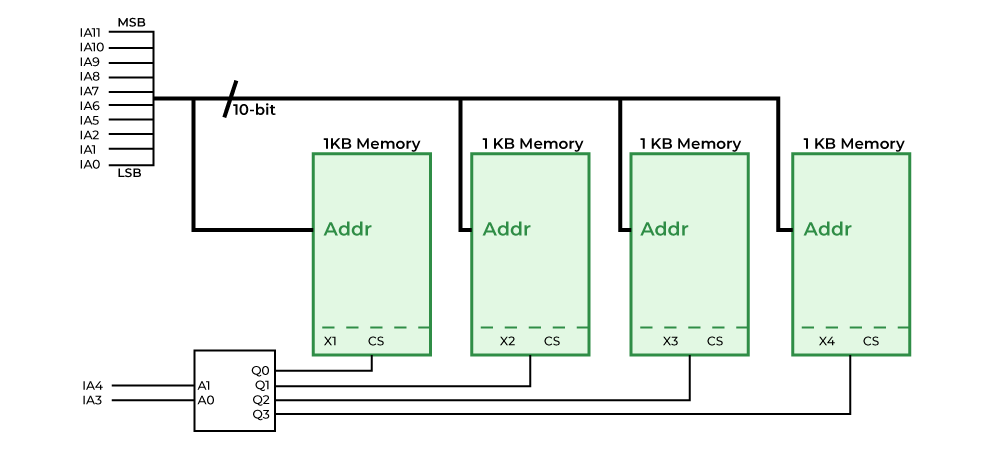GATE CSE 2023
Question 41
A 4 kilobyte (KB) byte-addressable memory is realized using four 1 KB memory blocks. Two input address lines (IA4 and IA3) are connected to the chip select (CS) port of these memory blocks through a decoder as shown in the figure. The remaining ten input address lines from IA11–IA0 are connected to the address port of these blocks. The chip select (CS) is active high.
[caption width="800"] [/caption]
[/caption]
The input memory addresses (IA11–IA0), in decimal, for the starting locations (Addr=0) of each block (indicated as X1, X2, X3, X4 in the figure) are among the options given below. Which one of the following options is CORRECT?
Question 42
Consider a sequential digital circuit consisting of T flip-flops and D flip-flops as shown in the figure. CLKIN is the clock input to the circuit. At the beginning, Q1, Q2 and Q3 have values 0, 1 and 1, respectively.
[caption width="800"] img[/caption]
img[/caption]
Which one of the given values of (Q1, Q2, Q3) can NEVER be obtained with this digital circuit?
Question 43
A Boolean digital circuit is composed using two 4-input multiplexers (M1 and M2) and one 2-input multiplexer (M3) as shown in the figure. X0–X7 are the inputs of the multiplexers M1 and M2 and could be connected to either 0 or 1. The select lines of the multiplexers are connected to Boolean variables A, B and C as shown.
[caption width="800"].png) [/caption]
[/caption]
Which one of the following set of values of (X0, X1, X2, X3, X4, X5, X6, X7) will realise the Boolean function A+ A.C+ A.B.C?
Question 44
Consider the IEEE-754 single precision floating point numbers P=0xC1800000 and Q=0x3F5C2EF4. Which one of the following corresponds to the product of these numbers (i.e., P × Q), represented in the IEEE-754 single precision format?
Question 45
Let A be a priority queue for maintaining a set of elements. Suppose A is implemented using a max-heap data structure. The operation EXTRACT-MAX(A) extracts and deletes the maximum element from A. The operation INSERT(A,key) inserts a new element key in A. The properties of a max-heap are preserved at the end of each of these operations.
When A contains n elements, which one of the following statements about the worst case running time of these two operations is TRUE?
Question 46
Let U = {1, 2,..., n}, where n is a large positive integer greater than 1000. Let k be a positive integer less than n.
Let A, B be subsets of U with |A| = |B| = k and A ∩ B = ∅. We say that a permutation of U separates A from B if one of the following is true.
1. All members of A appear in the permutation before any of the members of B.
2. All members of B appear in the permutation before any of the members of A.
How many permutations of U separate A from B?
Question 47
Let f: A → B be an onto (or surjective) function, where A and B are nonempty sets. Define an equivalence relation ∼ on the set A as
a1 ∼ a2 if f (a1) = f (a2) ,
where a1, a2 ∈ A. Let E = {[x] : x ∈ A} be the set of all the equivalence classes under ∼. Define a new mapping F : E → B as
F ([x]) = f (x), for all the equivalence classes [x] in E .
Which of the following statements is/are TRUE?
Question 48
Suppose you are asked to design a new reliable byte-stream transport protocol like TCP. This protocol, named my TCP, runs over a 100 Mbps network with a Round Trip Time of 150 milliseconds and a maximum segment lifetime of 2 minutes. Which of the following is/are valid lengths of the Sequence Number field in the my TCP header?
Question 49
Let X be a set and 2X denote the powerset of X. Define a binary operation Δ on 2X as follows:
AΔB = (A − B) ∪ (B − A)
Let H = (2X, Δ).
Which of the following statements about H is/are correct?
Question 50
Suppose in a web browser, you click on the www.gate-2023.in URL. The browser cache is empty. The IP address for this URL is not cached in your local host, so a DNS lookup is triggered (by the local DNS server deployed on your local host) over the 3-tier DNS hierarchy in an iterative mode. No resource records are cached anywhere across all DNS servers.
Let RTT denote the round trip time between your local host and DNS servers in the DNS hierarchy. The round trip time between the local host and the web server hosting www.gate-2023.in is also equal to RTT. The HTML file associated with the URL is small enough to have negligible transmission time and negligible rendering time by your web browser, which references 10 equally small objects on the same web server.
Which of the following statements is/are CORRECT about the minimum elapsed time between clicking on the URL and your browser fully rendering it?
There are 65 questions to complete.